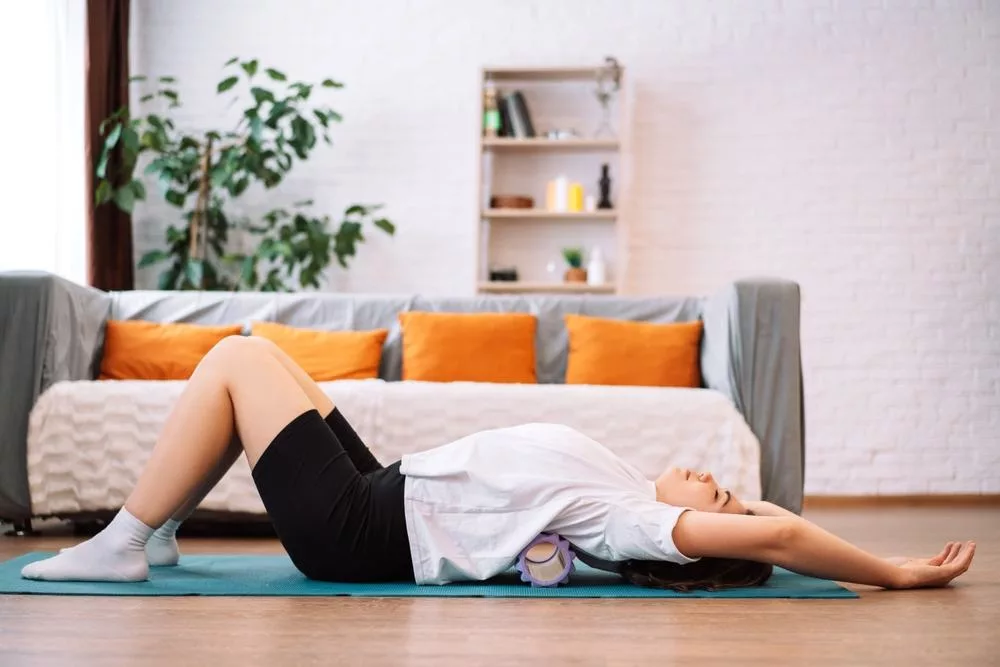Stretching breaks are crucial for your overall health and for your productivity in the workplace. When you sit or stand for long periods of time, this can cause muscle tension and stiffness. Stretching breaks can help reduce this tension and increase flexibility, which can result in less strain on your body. Stretching can also help reduce your stress levels by releasing tension in the body and helping you feel more focused and relaxed. You may be surprised to learn that simple stretches you can do at work can also help boost your energy levels! In between trips to your trusted chiropractor for helpful treatments like spinal decompression, here are five simple lower back stretches you can do at work!
The Importance of Having Stretching Breaks at Work
Taking stretch breaks at work helps you maintain good health and productivity in and out of the office. When you stretch, your body increases blood flow to your muscles, bringing fresh oxygen and nutrients to the area. While you might be stretching your lower back, stretch breaks can also promote heart health by improving your overall circulation. With increased oxygen and blood flow to your brain and body, you can experience an improvement in your overall mood and energy. Sitting for long periods of time can make you feel tired and lethargic. Taking regular breaks to stretch can also help reduce your risk of injuries or dealing with issues like chronic pain.
Prevent Back Pain with These 5 Lower Back Stretches at Work

Try these five lower back stretches at work that can all be done from a chair to help reduce muscle tension and stress while improving your energy levels and productivity throughout the day.
Seated Back Extensions
Seated back extensions target the muscles in your lower back. Sit on a chair with your feet flat on the ground and place your hands behind your head. Slowly arch your back and lean back into the chair until you feel a gentle stretch in your lower back. Hold this position for 10-15 seconds, then return to a seated position.
This stretch helps to strengthen the muscles that support your spine and reduce strain on your lower back. Seated back extensions can help improve your posture while also increasing the flexibility of your lower back. As the muscles in your lower back stretch and lengthen, this can alleviate stiffness and pain. Seated back extensions are a low-impact stretch that is gentle on your muscles and joints.
Seated Spinal Roll
Seated spinal rolls target the muscles that support your whole back. Sit with your feet flat on the ground and your hands resting on your knees. Slowly roll your spine forward, dropping your head towards your chest. Continue rolling forward until you reach the bottom of your spine, then slowly roll back up to a seated position. Repeat this motion 3-5 times.
This stretch promotes increased flexibility and mobility of your spine. The seated spinal roll can help alleviate stiffness and pain in your lower back by stretching these muscles and stimulating blood flow to the area. As you engage your back muscles with this stretch, it can also help reduce inflammation, tension, and stress. The seated spinal roll is a gentle and calming stretch that is great for taking a break at the office.
Chair Hamstring Stretch
Chair hamstring stretches target the muscles along the back of your thighs, known as your hamstrings. Sit on the edge of a chair with one leg straight out in front of you and the other foot flat on the ground. Lean forward from your hips and reach towards your toes. Hold this position for 10-15 seconds, then switch legs and repeat.
This stretch helps alleviate lower back pain by targeting the hamstrings. Increased flexibility and mobility in your hamstrings can reduce tension and strain on your lower back. The chair hamstring stretch helps improve your posture by bringing your pelvis and lower back into a healthier position. This low-impact stretch is gentle on your body and can help improve your overall range of motion.
Seated Spinal Twist/Rotation
Seated spinal twists target the muscles in your back and torso. Sit on a chair with your feet flat on the ground and your hands placed on the armrests or back of the chair. Slowly twist your torso to one side, using your hands to support your weight. Hold this position for 10-15 seconds, then gently twist to the other side and repeat.
This stretch involves moving your spine gently through a controlled range of motion. The seated spinal twist helps increase flexibility and mobility in your back, which helps to reduce pain and stiffness. By stretching your lower back muscles, you can experience reduced tension and discomfort in the area. The seated spinal twist also stimulates blood flow to the area and can be a calming exercise to promote relaxation and reduce stress.
Seated Knee-to-Chest Stretch
The seated knee-to-chest stretch targets the muscles in your lower back and hips. Begin by sitting on a chair with your feet flat on the ground. Lift one knee towards your chest and hug it with both hands, pulling it as close to your chest as you comfortably can. Hold this position for 10-15 seconds, then switch legs and repeat.
This stretch stretches the muscles that support your lower back, hips, and glutes to alleviate pain in these areas. The seated knee-to-chest stretch gently stretches your hip muscles to bring your hips and pelvis into proper alignment with your spine. As you stretch, the hip muscles begin to lengthen, which reduces tension and strain on your lower back. This low-impact stretch is a great option for gently increasing flexibility in the lower body.
How to Improve Posture While Working

Improving your posture while working can make a big impact on your back, neck, and shoulders. When you focus on a healthy posture while you work, you will likely experience less pain and discomfort throughout the day. Here are a few tips for how to improve your posture while you work:
Adjust Your Seating
Make sure your chair is at the correct height so that your feet can stay flat on the ground with your knees at a 90-degree angle. You may also adjust the backrest of your chair to help support the natural curve of your spine or use a lumbar support pillow for additional support.
Sit Up Straight
Whether you are sitting or standing, focus on keeping your shoulders back and down and ensure that your chest is lifted. Avoid postures like slouching or hunching forward, as this can put excess strain on your back and body.
Position Your Monitor
The location of your monitor can also contribute to a healthy or harmful posture at work. Position your monitor at eye level for the best results so you don’t have to tilt your head up or down to see the screen.
Remember to Stand Up and Take a Break at Work!
Standing up and taking breaks throughout the day does wonders for your health. Taking breaks to stand up, move around, and stretch can help reduce the risk of potential injuries or disorders. Even if you can only take a quick 3-minute break, standing up and stretching can help improve your posture by reducing strain on your back and neck. Plus, standing and taking breaks throughout the day can boost your energy, productivity, and even your mental health!
Persistent Back Pain Bothering You? Let Us Help
Overall, taking breaks to stand up, move around, and stretch is an important part of maintaining good health and productivity at work. You may also consider setting reminders or using tools like standing desks or fitness trackers to help you remember to take care of your body throughout the day. You can also meet with a Killeen chiropractor near you for regular check-ins to focus on your posture and overall health goals. Schedule an appointment today with Affordable Killeen Chiropractic to get started!

